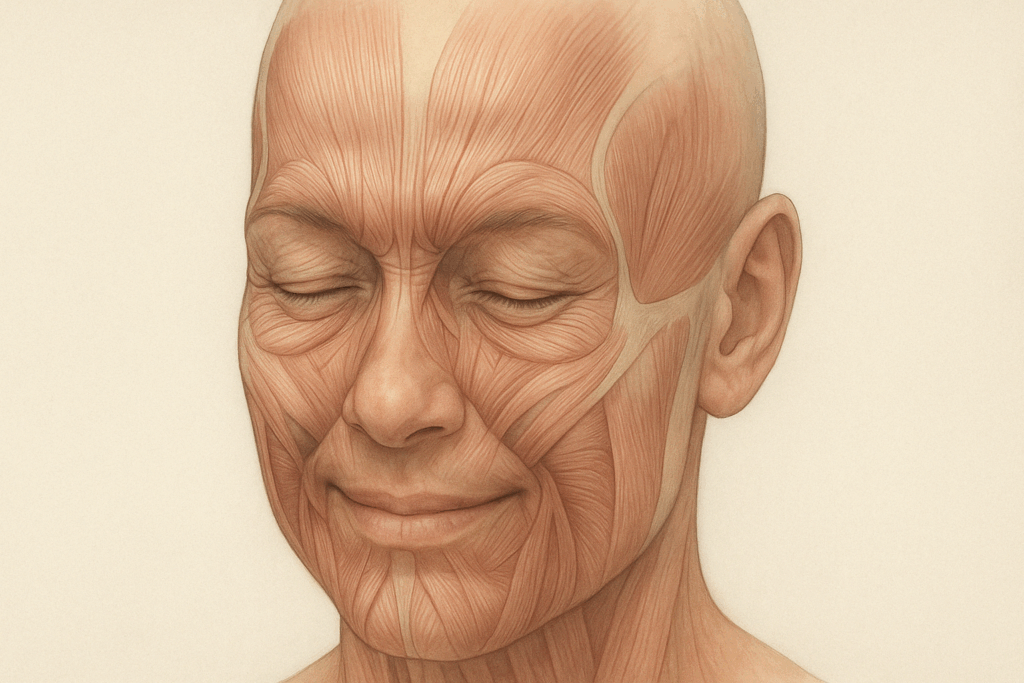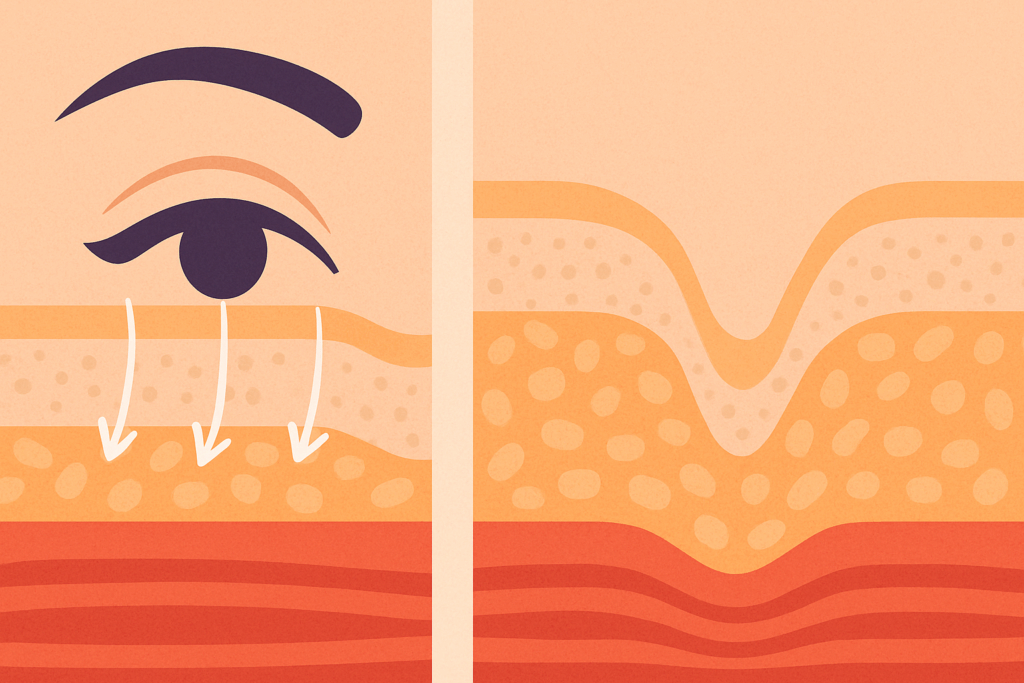Few phenomena are as intricately tied to both our identity and the passage of time as the changes that occur on our faces. Among these visible signs of aging, dynamic wrinkles stand out—not just because of their early appearance but due to their intimate connection to our most human qualities: facial expression, emotion, and communication. Despite their subtle beginnings, fast dynamic facial wrinkles often emerge long before we expect them, and understanding their origins requires a journey into both the biology of skin and the psychology of expression. In this exploration, we will delve into the science of how these wrinkles form, why they appear more quickly than other types of skin aging, and what this means for mental and physical health across the lifespan.
You may also like: How to Choose Skin Care for Fine Lines: Evidence-Based Tips for Healthier, Younger-Looking Skin

Understanding Dynamic Wrinkles: More Than Skin Deep
Dynamic wrinkles are the fine lines and folds that result from repetitive muscle movements under the skin, such as smiling, frowning, squinting, or raising the eyebrows. These movements, essential for emotional expression and social interaction, create predictable creases in areas of high facial activity, including the forehead, around the eyes (crow’s feet), and between the brows (glabellar lines). While static wrinkles develop due to gravity, loss of collagen, and sun damage over time, dynamic wrinkles are forged in motion. They first appear only during expressions but eventually become etched into the skin’s surface, remaining visible even when the face is at rest.
The speed at which dynamic wrinkles develop—what some describe as fast dynamic facial wrinkles—depends on a combination of genetic, environmental, and behavioral factors. Repeated contraction of facial muscles creates shear stress in the skin’s dermal layer. Over time, this repeated tension breaks down collagen and elastin, the proteins responsible for skin elasticity and firmness. Unlike other aging processes that unfold gradually, dynamic wrinkling can accelerate based on how often, intensely, and habitually one uses particular facial muscles.

The Biology of Facial Expression and Skin Structure
Facial expressions are powered by a complex network of muscles known as the mimetic muscles. These muscles are unique in that they attach to the skin rather than to bones, allowing subtle movements to instantly change our facial appearance. When a person smiles or furrows their brow, the contraction of these muscles tugs at the overlying skin, folding it into shapes that mirror emotional states. In youth, the skin’s resilience allows it to bounce back quickly. However, with age, and particularly with high-frequency expressions, the skin’s ability to recover diminishes.
The loss of key structural proteins in the dermis—collagen and elastin—is a crucial turning point in wrinkle formation. Collagen provides tensile strength, while elastin grants skin its stretch and rebound qualities. In dynamic areas, where the skin is perpetually in motion, these proteins degrade at a faster rate. This degradation is exacerbated by intrinsic aging, hormonal changes, and lifestyle factors such as ultraviolet (UV) radiation, smoking, and inadequate skin hydration.
Repeated use of certain muscles, especially those associated with stress, worry, or habitual expressions, intensifies this wear and tear. This is why individuals who frequently frown or squint, either due to personality traits or environmental exposures like bright sunlight, often show fast dynamic facial wrinkles in those specific regions. The skin simply loses its ability to spring back into its original shape after being folded repeatedly, making these expressions more permanent over time.

Psychosocial Implications of Dynamic Wrinkles
The appearance of dynamic wrinkles carries more than aesthetic implications. As mirrors of our emotions, these facial lines also influence how others perceive us and how we perceive ourselves. For instance, deep furrows between the brows may be interpreted as signs of anger or worry, even when no such emotion is present. This can lead to miscommunication, social discomfort, or assumptions about one’s mood or personality.
Moreover, dynamic wrinkles can affect mental well-being by altering self-image. In a culture that often equates youthfulness with vitality and attractiveness, the early onset of visible aging may contribute to diminished self-esteem, especially when these changes conflict with internal perceptions of self. Psychological studies have shown that individuals who are more aware or concerned about aging signs, including fast dynamic facial wrinkles, may experience greater anxiety, particularly in professional or social contexts that emphasize appearance.
Interestingly, the brain’s feedback loop between facial expression and emotion means that dynamic wrinkles can subtly influence our internal state as well. Known as the facial feedback hypothesis, this theory suggests that our facial expressions do not merely reflect our emotions—they also shape them. A habitual frown may reinforce feelings of tension or sadness, while a frequent smile can support a more positive emotional tone. When dynamic wrinkles lock these expressions into place, they may unconsciously impact emotional regulation and mood over time.

Why Dynamic Wrinkles Form Faster Than You Think
What sets dynamic wrinkles apart in terms of speed is their constant exposure to both external and internal stressors. Unlike static wrinkles that are largely passive responses to time and environmental damage, dynamic wrinkles are forged through daily repetition. Even the most subtle facial movement, when performed thousands of times per day, contributes incrementally to the shaping of the skin. Over time, this mechanical stress compounds, especially in individuals whose jobs, habits, or personalities involve expressive facial behavior.
Skin thickness and muscle mass also play a role in wrinkle acceleration. In thinner skin—such as the periorbital area around the eyes—the effects of dynamic movement are more pronounced, leading to earlier formation of crow’s feet. Gender and hormonal differences can influence this process as well. Estrogen, for example, plays a protective role in collagen synthesis; thus, postmenopausal women often experience a more rapid onset of dynamic wrinkles due to hormonal shifts.
Environmental factors contribute another layer to this equation. UV radiation is particularly damaging to collagen and elastin fibers, making sun protection essential for slowing wrinkle development. Similarly, oxidative stress from pollution and lifestyle behaviors like smoking can accelerate cellular aging, weakening the skin’s repair mechanisms. When compounded with repeated facial movements, these influences hasten the arrival of fast dynamic facial wrinkles far earlier than many expect.

The Role of Preventative Care and Early Intervention
Because dynamic wrinkles are driven largely by habitual muscle activity, interventions that either reduce muscle contraction or improve skin resilience can be highly effective in delaying their onset. The most well-known preventive approach is the use of neuromodulators, such as botulinum toxin (Botox), which temporarily weaken targeted facial muscles. By reducing the intensity of contraction, these treatments can prevent the formation of expression lines before they become permanent. However, this is just one facet of a broader prevention strategy.
Daily skincare regimens that include antioxidants, retinoids, and moisturizers can strengthen the skin barrier and support collagen renewal. Retinoids, derivatives of vitamin A, are especially useful in dynamic areas because they stimulate fibroblasts to produce collagen and normalize cell turnover. Antioxidants like vitamin C neutralize free radicals caused by sun and pollution, reducing the oxidative stress that accelerates collagen breakdown.
Lifestyle factors are equally important. Regular use of broad-spectrum sunscreen with an SPF of 30 or higher can significantly slow the breakdown of dermal proteins. Staying well-hydrated, eating a diet rich in omega-3 fatty acids and phytonutrients, and avoiding tobacco smoke are all scientifically supported strategies for maintaining skin integrity. Stress management, too, plays a subtle but meaningful role. Chronic stress not only prompts frequent frowning but also increases cortisol, which can impair skin repair and collagen synthesis.
The Emotional Complexity Behind Wrinkle Formation
It is important not to oversimplify the narrative around wrinkle prevention. Facial expressions are deeply embedded in our emotional life and social interactions. To suppress them entirely would be both unnatural and potentially harmful to emotional well-being. Dynamic wrinkles, after all, are not merely signs of aging but markers of a life lived with expression. They reflect our joys, sorrows, anxieties, and amusements. Therefore, a balanced approach is necessary—one that honors the importance of emotional expression while offering strategies to preserve skin health.
This perspective reframes the discussion around fast dynamic facial wrinkles. Instead of viewing them solely as flaws to be erased, they can be seen as symbols of vitality, communication, and human connection. At the same time, acknowledging the science behind their formation empowers individuals to make informed choices—whether they opt for preventative treatments, embrace the lines as part of their identity, or explore somewhere in between.
When Dynamic Wrinkles Signal More Than Aging
In some cases, the appearance of dynamic wrinkles may also serve as an early indicator of underlying health changes. For instance, research has shown a correlation between increased forehead wrinkling and cardiovascular risk, possibly due to shared mechanisms involving oxidative stress and vascular integrity. Although more studies are needed to confirm causality, the skin’s condition often reflects internal health.
Neurological conditions can also influence facial expression patterns. Individuals with Parkinson’s disease, for example, may exhibit reduced facial mobility, known as hypomimia, which alters the pattern and location of wrinkle formation. In contrast, certain psychiatric disorders, including anxiety and chronic stress disorders, may intensify muscle tension in the forehead and around the eyes, accelerating dynamic wrinkle formation in those areas. Understanding these connections enhances our ability to interpret the skin as a window into broader physiological states.

Looking Forward: Innovations in Dermatological Science
Dermatological science continues to evolve in its understanding of facial aging and wrinkle development. Advances in bioengineering, for instance, are exploring how 3D bioprinting and regenerative medicine can restore skin volume and elasticity at the cellular level. These technologies may one day allow for precise rebuilding of collagen and elastin fibers in dynamic zones without the need for invasive procedures.
Additionally, wearable devices that monitor facial muscle activity are being developed to help individuals become more aware of habitual expressions. By identifying muscle overuse in real-time, these tools can support behavioral interventions aimed at reducing unnecessary tension. Coupled with mindfulness training or biofeedback, such innovations may offer a new frontier in preventative skin aging—especially for those concerned with fast dynamic facial wrinkles but hesitant about injectable treatments.
Moreover, genetic testing is beginning to inform personalized skincare strategies. Some individuals may have genetic predispositions to faster collagen loss or reduced antioxidant defenses, guiding tailored interventions that better align with their unique skin biology. As this field grows, we may see a shift from generalized anti-aging protocols to precision dermatology that accounts for individual variations in wrinkle development.
Reconsidering the Value of Aging Gracefully
While science equips us with tools to understand and possibly slow the progression of dynamic wrinkles, the broader cultural conversation around aging must also evolve. Wrinkles should not be feared or stigmatized. In many ways, they reflect a person’s expressive depth, social bonds, and emotional richness. Rather than striving to erase them entirely, a more compassionate and health-conscious approach embraces prevention, care, and self-acceptance in equal measure.
Ultimately, the appearance of fast dynamic facial wrinkles is not simply a cosmetic issue but a biopsychosocial phenomenon. It weaves together the threads of dermatology, psychology, lifestyle, and self-image into a complex tapestry of human aging. A nuanced understanding of this process encourages healthier relationships with our appearance and fosters informed decision-making rooted in evidence, not fear.
Frequently Asked Questions: Understanding Fast Dynamic Facial Wrinkles and Expression-Driven Aging
What makes fast dynamic facial wrinkles different from other types of wrinkles?
Fast dynamic facial wrinkles develop from repetitive muscle activity, but their speed and early appearance set them apart from static wrinkles caused by gravity or sun damage. Unlike deeper, more permanent lines that take decades to form, fast dynamic facial wrinkles can emerge in individuals as early as their twenties or thirties depending on facial expressiveness and lifestyle. One underexplored factor is digital facial strain—extended time spent staring at screens can lead to unconscious squinting or furrowing of the brow, accelerating these wrinkles. Additionally, people in performance-based or high-emotion professions (such as actors or teachers) often show faster onset due to the expressive demands of their work. This nuance explains why prevention strategies must begin earlier for dynamic wrinkles than for other signs of aging.
Can emotional regulation techniques reduce the formation of dynamic wrinkles?
Yes, emotional regulation may play an indirect yet impactful role in slowing the development of fast dynamic facial wrinkles. When we cultivate awareness around our facial reactions to stress or conflict, we often reduce the frequency of furrowed brows or clenched jaws—expressions linked to wrinkle formation. Mindfulness-based practices, such as body scans or breathing techniques, help bring attention to habitual facial tension. Over time, reducing these unconscious expressions could slow the skin’s exposure to mechanical stress in dynamic regions. While emotional regulation isn’t a substitute for dermatological care, it complements a wrinkle prevention strategy by addressing root behavioral contributors to dynamic wrinkles.
Are there any sleep-related habits that can worsen fast dynamic facial wrinkles?
Absolutely—sleep posture and quality significantly influence the progression of dynamic wrinkles. People who sleep with their face pressed against a pillow may unknowingly deepen creases on one side of their face, especially in the nasolabial and periorbital zones. This asymmetrical pressure reinforces dynamic wrinkles formed during the day, particularly if paired with high facial expressiveness. Sleep deprivation also raises cortisol levels, which impairs skin regeneration and elasticity, compounding the visible impact of facial motion. Investing in silk or satin pillowcases and training oneself to sleep on the back can reduce unnecessary skin folding during sleep and help delay the onset of fast dynamic facial wrinkles.
Do dietary choices influence the severity or progression of dynamic wrinkles?
Emerging research suggests that certain nutrients can help mitigate the structural skin loss associated with fast dynamic facial wrinkles. Diets rich in polyphenols—found in berries, green tea, and olives—help neutralize oxidative stress, a key contributor to collagen breakdown in expression-prone areas. Meanwhile, protein and vitamin C intake supports collagen synthesis, which is especially crucial in dynamic facial zones subject to frequent movement. Conversely, high-glycemic diets and frequent sugar consumption may accelerate glycation, a process that stiffens collagen fibers and increases wrinkle depth. In this way, nutrition becomes a powerful tool for supporting skin resilience against the formation of dynamic wrinkles.
Are fast dynamic facial wrinkles reversible once they’ve formed?
Complete reversal of fast dynamic facial wrinkles is unlikely without clinical intervention, but their appearance can be significantly softened. Modalities like fractional laser resurfacing and microneedling stimulate collagen remodeling, improving skin elasticity even in high-movement zones. Topically, peptides and retinoids enhance cellular turnover and dermal support, although results require sustained use and are more effective at reducing fine lines than deep creases. Injectable neuromodulators remain the most effective for dynamic wrinkle correction by targeting the underlying muscle activity. However, early-stage wrinkles respond best to non-invasive strategies, emphasizing the importance of proactive care before lines become deeply etched.
What are some emerging technologies for managing dynamic wrinkles in real time?
A new frontier in wrinkle prevention involves wearable technologies designed to track facial muscle activation. These discreet biosensors provide biofeedback, alerting users when they’re engaging in repetitive or tension-inducing expressions that contribute to fast dynamic facial wrinkles. Some devices even pair with apps that log expression frequency and offer relaxation cues or mindfulness prompts. Additionally, AI-driven mirror interfaces can detect early changes in wrinkle depth and skin resilience, helping individuals adjust their habits before changes become permanent. These tools make it easier to adopt preventative behaviors by offering personalized, real-time insight into the muscle movements that accelerate dynamic wrinkles.
Can occupational behaviors influence dynamic wrinkle patterns?
Yes, occupational roles that require frequent expressive communication can contribute to the asymmetric or premature development of dynamic wrinkles. Public speakers, therapists, sales professionals, and those in customer-facing roles often engage in repetitive emotional expressions that deepen specific facial lines. For example, someone who habitually raises their eyebrows when listening may develop pronounced forehead wrinkles earlier than others. Jobs that require prolonged screen time can also lead to tension in the glabellar region, fostering fast dynamic facial wrinkles between the brows. Understanding how work-related expression patterns affect skin aging can empower individuals to build counter-strategies, such as using facial relaxation exercises between meetings.
How do hormonal shifts affect dynamic wrinkle formation?
Hormonal changes, particularly in estrogen and testosterone levels, directly impact skin quality and dynamic wrinkle development. Estrogen promotes collagen production and water retention, both of which support skin elasticity. After menopause, estrogen declines rapidly, reducing dermal thickness and making the skin more vulnerable to repetitive motion damage. This is one reason women may see fast dynamic facial wrinkles appear more sharply post-menopause, especially in the perioral and forehead areas. Hormonal changes also affect sebum production, which influences the skin’s barrier function and its ability to resist mechanical stress. Discussing hormone health with a provider may offer additional insights into skin maintenance strategies during life transitions.
Is there a link between personality traits and the likelihood of developing dynamic wrinkles?
Fascinatingly, studies suggest a subtle correlation between personality traits and the type or location of dynamic wrinkles that form. People high in neuroticism or emotional intensity may experience more frequent frowning or expressive worry, which can lead to faster development of wrinkles in the glabellar and periorbital regions. Conversely, those with an optimistic or joyful disposition may develop more prominent smile lines or crow’s feet due to habitual grinning. While genetics and lifestyle also play a critical role, these behavioral patterns help explain why fast dynamic facial wrinkles often appear in characteristic regions tied to emotional tendencies. Recognizing these patterns can help tailor prevention efforts to align with personality-driven expressions.
How might cultural attitudes about aging affect our perception of dynamic wrinkles?
Cultural context deeply influences whether dynamic wrinkles are viewed as signs of wisdom and experience or as flaws to be corrected. In some East Asian and Indigenous cultures, facial lines are seen as honorable markers of emotional depth, encouraging a more accepting view of aging. In contrast, Western beauty standards often prioritize smooth, youthful skin, framing fast dynamic facial wrinkles as cosmetic concerns. These perspectives affect not only how individuals feel about their appearance but also their willingness to seek or avoid intervention. Embracing a diverse understanding of aging can help people make decisions about wrinkle care that are informed, rather than pressured, by cultural norms.
Conclusion: Embracing the Science—and Humanity—Behind Dynamic Wrinkles
In the end, dynamic wrinkles are more than just superficial changes in the skin. They are physiological markers of emotional life, physical habits, and environmental exposures. The rapid development of these lines—what some refer to as fast dynamic facial wrinkles—stems from a dynamic interplay of muscle movement, skin biology, and lifestyle. Though they often appear earlier than we expect, these wrinkles tell a meaningful story about how we live, how we feel, and how we connect with others.
Understanding the science behind dynamic wrinkles equips us to respond not with fear or urgency, but with intention and care. Through preventive strategies, skin-supportive routines, and informed medical interventions, individuals can slow their progression while maintaining expressive freedom. At the same time, appreciating the psychological and cultural dimensions of facial aging fosters a more compassionate perspective—one that honors the emotional complexity and beauty of the human face.
In a world that often encourages us to conceal signs of aging, there is quiet power in understanding them instead. Dynamic wrinkles may form faster than we think, but they are far from meaningless. They are reminders of our vitality, our interactions, and our stories. And when we view them through the lens of science and self-awareness, they become not just features to manage, but features to respect.
Was this article helpful? Don’t let it stop with you. Share it right now with someone who needs to see it—whether it’s a friend, a colleague, or your whole network. And if staying ahead on this topic matters to you, subscribe to this publication for the most up-to-date information. You’ll get the latest insights delivered straight to you—no searching, no missing out.
Further Reading:
The Science Behind Wrinkles and How They Develop
Why Your Face Ages Faster Than Your Body
The Facial Aging Process From the “Inside Out” – PMC
Disclaimer
The information contained in this article is provided for general informational purposes only and is not intended to serve as medical, legal, or professional advice. While Health11News strives to present accurate, up-to-date, and reliable content, no warranty or guarantee, expressed or implied, is made regarding the completeness, accuracy, or adequacy of the information provided. Readers are strongly advised to seek the guidance of a qualified healthcare provider or other relevant professionals before acting on any information contained in this article. Health11News, its authors, editors, and contributors expressly disclaim any liability for any damages, losses, or consequences arising directly or indirectly from the use, interpretation, or reliance on any information presented herein. The views and opinions expressed in this article are those of the author(s) and do not necessarily reflect the official policies or positions of Health11News.